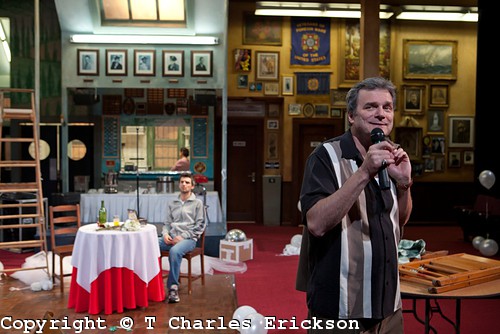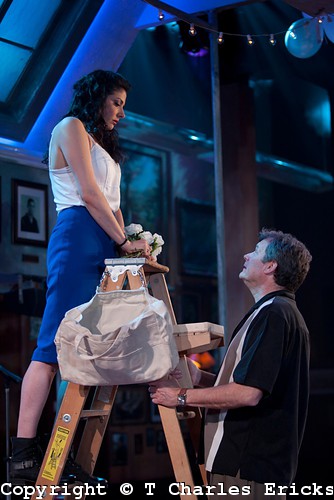JOHN PROCCACINO, MIKE CRANE AND (IN THE PHOTO NEAR THE END OF THE ARTICLE) LISA BIRNBAUM IN THE LONG WHARF THEATRE PRODUCTION OF ITALIAN-AMERICAN RECONCILIATION. PHOTOS BY T. CHARLES ERICKSON.
If you don’t know Italian-American Reconciliation, you really should. It’s one of the earliest and funniest plays from John Patrick Shanley, who’d been leading up to this 1986 success with such fractious Bronx relationship plays as the dramatic comedy Danny and the Deep Blue Sea and the comedic drama Savage in Limbo. Shanley went on to create the movies Moonstruck (strikingly similar to Italian-American Reconciliation) and Joe vs. the Volcano (completely different from anything else he’s ever written. Just a few years ago Shanley won a Pulitzer for Doubt. The Long Wharf Theatre production of Italian-American Reconciliation is currently in previews, and opens to the press May 3.
If you don’t know John Proccacino (at right in the photo above), you really should. Many of his stage credits may have been forged in the regional theaters of Seattle, but Long Wharf has had a line on him for many years, from Anne Meara’s Down the Garden Path to Dario Fo’s We Won’t Pay! We Won’t Pay! to Eugene O’Neill’s A Moon for the Misbegotten and several others besides.
But if you do know Shanley’s play, and you are familiar with Proccacino’s amiably anxious acting style, you might find yourself wondering, who the heck does he play in it?
He plays Aldo Scalicki, a character described in the script as “an intense Italian guy, about thirty years old.” Proccacino’s intense and Italian, all right, but he was born in 1952. Last time he appeared at Long Wharf, in A.R. Gurney’s Sylvia, he played a man who’d been married for decades. Time before that, in Craig Lucas’ Prayer for My Enemy, he played the father of a guy in his 20s. His most recent acting role, at the Old Globe in San Diego this past February, was as the neighbor Charley in Death of a Salesman.
And that, says the show’s director Eric Ting (who also directed Proccacino in Sylvia), is exactly the sort of Aldo he wanted. He and Proccacino discussed Italian-American Reconciliation over coffee at the Book Trader on Chapel Street (though Ting, who’s also the Long Wharf’s associate artistic director and a resident of downtown New Haven, also frequents JoJo’s coffee shop at Chapel and Park).
“The big conceit is that we’re setting it within the frame of the narrator, Aldo,” Ting says. What in most productions comes off as explanatory omniscient patter is, in the Long Wharf production, staged as a sort of flashback.
Ting can justify his concept several different ways. Though the play centers on the relationship between Huey Bonfigliano, his current girlfriend Teresa and his ex-wife Janice (whom Huey still pines for), Ting feels that the trenchant observations of Huey’s best friend Aldo make him much more than a supporting character. Ting points out that Aldo is the same age as Shanley was when he wrote the play, and at times seems to voice the playwright’s worldview.
Building the narrative around memories—memories which this production leads you to believe may have been altered or edited or reconsidered over time—gives Aldo a stronger voice.
Ting mentions “a line in Aldo’s closing monologue,” which Proccacino then proceeds to recite by heart:
The story I set out to tell was about Huey Maximilian Bonfigliano and me, an’ what happened to him. And I’ve told it. And I’ll probably tell it again and again, other nights, other places. ‘Til it’s done with being told. ‘Til I’m done with tellin’ it. Which may never be.
The storytelling approach also allows the production to be vaguely contemporary and also vaguely set in the 1980s, when the play was written. “There’s a dated quality,” Ting muses. “How do you make it immediate?”
Scott Bradley‘s set design doesn’t transport you directly to Little Italy, or to the Italian neighborhood diner/coffeehouse where Shanley’s script begins. It shows you Proccacino off by himself in an empty banquet hall, having just endured a long wedding reception. The walls of the hall are covered with photos of Italian-American families, real New Haven ones, lent to the Long Wharf by the sorts of folks who might well recognize themselves in this play. A press release from the theater back in March, soliciting not just photos but answers to the question “What does it mean to be Italian American today?,” noted that “nearly 20 percent of Connecticut residents surveyed in the 2009 U.S. Census said they had Italian ancestry, outpacing New Jersey and New York. … New Haven particularly was known as a nexus for Italian immigrants upon arriving in America.”
Some answers to the “What does it mean…?” question can be found in a Long Wharf lobby display. Others can be found onstage:
Listen, Huey, a lotta people have an expression of this problem. They had something horrible for a long time, and then they get away from it, and then they miss it. They want the horrible thing back. But only in the very very blindest stupidest way. This is where friends come in.
So, Proccacino is Aldo then. Which means the actor has to have a gun pointed at his kneecaps, right?
“Yes,” Ting laughs, “especially in rehearsal.”
John Proccacino knew Eric Ting thought he could nail this role—they’d discussed it for years, when Ting had pitched the show for previous Long Wharf seasons. But, the actor admits, “I had never done Shanley. I did not know the play. I started to kick around how to make this work as I’m not in my 30s. What makes it work, I discovered, is that Aldo breaks the fourth wall.” The very first scene in Shanley’s script, in fact, stipulates that the character “talks to the audience.”
“It works,” Proccacino continues, “so I can just be me. It’s fun revisiting moments when you were that age, with those who are that age.” (The actors playing Huey, Teresa and Janice—Mike Crane, Stephanie DiMaggio and 2007 Yale School of Drama grad Lisa Birnbaum—are all 20- or 30-something.)
“It’s not a family play, but it’s like a family play. They’ve got problems! Mental and emotional problems!”
“All the obstacles,” Ting interjects, “to finding love.”
“You come into adolescence and adulthood,” Proccacino says, “not knowing how to love. We’re trying to tell a story about that. Every character in this play has a rich history.”
Ting again: “There’s this whole idea of how people in a certain community communicate. Stepahnie DiMaggio, who plays Teresa, comes from an Italian family, and she has a reference for every question that comes up in rehearsals.”
Proccacino: “You can’t hold back with these characters. There’s nothing subtle about them. These people are not afraid to be alive. They’re not afraid to interact. They just say what’s on their mind.”
Ting: “That’s the secret to John Patrick Shanley’s long monologues. They have to be so long because the characters discover what they are saying in the course of speaking.”
Proccacino: “You have to learn them exactly. There’s a musicality in Shanley’s writing. His syntax is a little screwy. If you try to ‘correct’ that, you’ll hurt yourself, and you’ll hurt the play.”
The director’s and the actor’s banter starts to resemble the back-and-forth revelations in Shanley’s play—only nicer. And nobody pulls a zipgun.
Even with a key concept locked in just through the casting, it’s still taken some experimentation to nail the right tone, pace and style. Italian-American Reconciliation can been played heavily (it’s quite the emotional powderkeg) and it can be played extremely broadly (especially if those New York Little Italy accents get overdone). “We’re aiming straight down the middle,” asserts Ting. “As with when we did Sylvia, the right amount of time has passed” so that the audience won’t bring certain expectations and the company has room to reinterpret.
“Honestly, we have more fun in rehearsals…,”Proccacino begins, then turns to Ting. “You create a good room. You make it fun and comfortable for us to fail. That’s important in rehearsals, that you feel you can fail, that you can experiment. It’s been an awful lot of fun. I can’t wait to do it in front of an audience.”




It’s easy and will only take a few minutes to complete.
The crop hairstyle has been popular since the 1920.
You need not always go for bridal makeup hairstyles done by experts.